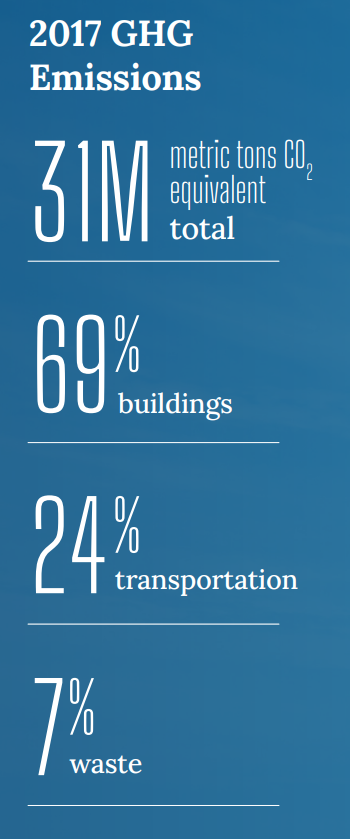Electrify Chicago
According to the
2022 Chicago Climate Action Plan,
a whopping 69% of Chicago's emissions come from buildings, making it
our biggest challenge and our biggest opportunity as a city to tackle
change. At Electrify Chicago we want to showcase some of the best and worst performing
buildings in the city using publicly available data and manual annotations to add
building photographs and label multi-building owners like universities.
You can start by looking at Chicago's buildings with the highest greenhouse gas intensity - this means that they use the most energy when adjusted per unit of square foot, so big buildings could actually perform much better than very inefficient small buildings on this metric.
Legislative update! 🎉
As of late January 2024, legislation is being introduced to require new buildings use more efficient forms of water and space heating, via the Clean And Affordable Buildings Ordinance (CABO), which will reduce the number of highly polluting and inefficient that end up on this site.
If you're in Chicago,
write to your alderman to support the CABO!
Chicago Buildings by Greenhouse Gas Intensity
Note: Data only includes large Chicago buildings from 2021, unless explicitly stated otherwise.
Note: This data only includes buildings whose emissions are reported
under the
Chicago Energy Benchmarking Ordinance. According to the City “As of 2016,
this list includes all commercial, institutional, and residential buildings larger than
50,000 square feet.” This dataset is also then filtered to only buildings with
reported emissions > 1,000 metric tons CO2 equivalent.
This data is also from 2021, but when new benchmark data is available, we'll update the site.
| Property Name / address | Primary Property Type |
Greenhouse Gas Intensity (kg CO2 eq./sqft) |
Total Greenhouse Emissions (metric tons CO2 eq.) |
|---|---|---|---|
|
International House
(UChicago)
1414 E 59th St
| Residence Hall/Dormitory | 6.3 kg/sqft
Lowest 47%
| 1,495 tons
Highest 31%
|
|
Kilpatrick Renaissance
4655 W Berteau Ave
| Multifamily Housing | 6.3 kg/sqft
Lowest 47%
| 500 tons
Lowest 27%
|
|
6200-42 N Hoyne
6200-42 N Hoyne Ave
| Multifamily Housing | 6.3 kg/sqft
Lowest 47%
| 1,038 tons
Highest 44%
|
|
Washington D Smyser Elementary School
(CPS)
4310 N Melvina Ave
| K-12 School | 6.3 kg/sqft
Lowest 47%
| 493 tons
Lowest 26%
|
|
Charles R Darwin Elementary School
(CPS)
3116 W Belden Ave
| K-12 School | 6.3 kg/sqft
Lowest 47%
| 761 tons
Lowest 45%
|
|
James Monroe Elementary School
(CPS)
3651 W Schubert Ave
| K-12 School | 6.3 kg/sqft
Lowest 47%
| 778 tons
Lowest 46%
|
|
Hawthorne Elementary Scholastic Academy
(CPS)
3319 N Clifton Ave
| K-12 School | 6.3 kg/sqft
Lowest 47%
| 449 tons
Lowest 22%
|
|
Clybourn
2601 N Clybourn St
| Retail Store | 6.3 kg/sqft
Lowest 47%
| 905 tons
Highest 49%
|
|
Yards Forman Mills
4520 S Damen Ave
| Retail Store | 6.3 kg/sqft
Lowest 47%
| 335 tons
Lowest 12%
|
|
Ten East Delaware
10 E Delaware Pl
| Multifamily Housing | 6.3 kg/sqft
Lowest 47%
| 2,324 tons
Highest 19%
|
|
474 North Lake Shore Drive
474 N Lake Shore Dr
| Multifamily Housing | 6.3 kg/sqft
Lowest 47%
| 3,489 tons
Highest 11%
|
|
757 Orleans at Chicago
757 N Orleans St
| Multifamily Housing | 6.3 kg/sqft
Lowest 47%
| 2,005 tons
Highest 23%
|
|
222 E Pearson Condominium Association
222 E PEARSON ST
| Multifamily Housing | 6.3 kg/sqft
Lowest 47%
| 1,399 tons
Highest 34%
|
|
1500 Lakeshore Drive Building Corp.
1500 N Lakeshore Dr
| Multifamily Housing | 6.3 kg/sqft
Lowest 47%
| 1,807 tons
Highest 26%
|
|
CH10 - Chicago South
11840 S Marshfield Ave
| Office | 6.3 kg/sqft
Lowest 47%
| 812 tons
Lowest 47%
|
Data Source:
Chicago Energy Benchmarking Data
